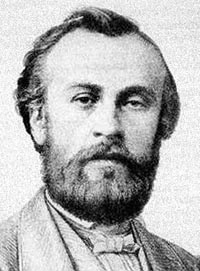Henri Giffard
Baptiste Henri Jacques Giffard (born January 8, 1825 in Paris ; † April 1882 there ) was a French engineer and aviation pioneer , who made a special contribution to the use of steam power as a propulsion system for aviation.
Live and act
Steam technology
The inventor was enthusiastic about steam engines . After studying at the Collège royal de Bourbon , he began as a technical draftsman on the St. Germain railway line . He made a fortune by improving steam engines. He developed z. B. a revolutionary steam jet pump (see picture).
Airship travel
Around seven decades after Jean-Baptiste Meusnier de la Place , Giffard took up his ideas for the first time. After helping the French engineer Jullien to build an airship in 1850 , the propeller of which was driven by a clockwork , in 1851 he applied for a patent on the “use of steam in airship travel”.
Together with two young engineers, Giffard built a cigar-shaped airship with a length of 44 meters and a diameter of 12 meters that held 2500 m³ of gas. The airship was propelled by a 45 kilogram, 3 hp steam engine. The ship took off for the first time on September 24, 1852. The 27.5 km long flight from Paris to Trappes at a speed of eight kilometers per hour is considered the first manned motorized flight in history. Already after this first flight Giffard realized that the dead weight of the steam engine was too high and that its performance was insufficient.
Another, likewise steam-powered airship exploded during a test flight in 1855. Giffard and his companion escaped the flames unharmed. However, interest in building airships and balloons sank noticeably at this point.
In 1878 Giffard built a spherical tethered balloon with a diameter of 36 m and a volume of around 24,400 m³. During the World Exhibition in Paris in 1878 , the balloon ( Le Grand Ballon Captif ) with its gondola that could hold up to 52 people was released on a 600 m long rope. The balloon was one of the attractions of the world exhibition and carried around 35,000 people during that time.
End of life
Because he could not come to terms with the onset of blindness, Giffard put an end to his life in 1882. His name is immortalized on the Eiffel Tower, see: The 72 names on the Eiffel Tower . Giffard Cove , a bay in Antarctica, has been named after him since 1960 .
literature
- Günter Schmitt, Werner Schwipps: Pioneers of early aviation . Gondrom Verlag, Bindlach 1995, ISBN 3-8112-1189-7 .
Web links
Individual evidence
- ^ The Giffard Airship, 1852 ( Memento April 6, 2012 in the Internet Archive ) ( Science Museum , London; English)
- ↑ Helmut Braun: The rise and fall of airship travel - an economic historical analysis. eurotrans-Verlag, Regensburg 2007, ISBN 3936400229 , p. 88 f.
| personal data | |
|---|---|
| SURNAME | Giffard, Henri |
| ALTERNATIVE NAMES | Giffard, Baptiste Henri Jacques |
| BRIEF DESCRIPTION | French aviation pioneer |
| DATE OF BIRTH | January 8, 1825 |
| PLACE OF BIRTH | Paris |
| DATE OF DEATH | April 1882 |
| Place of death | Paris |




